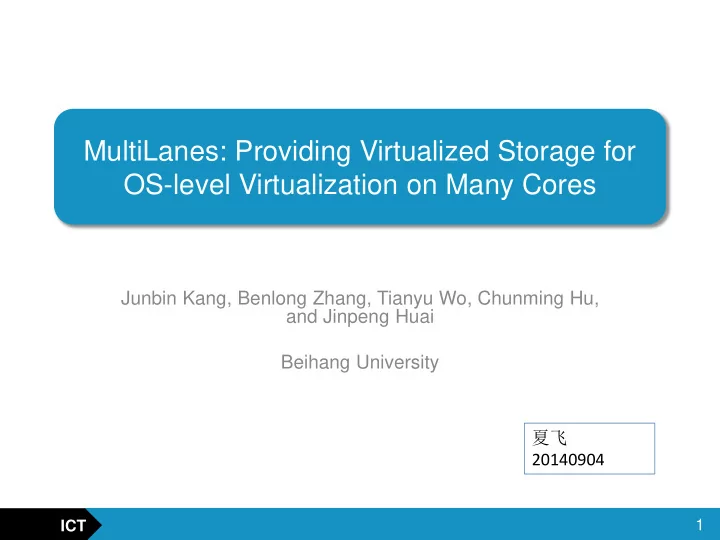

MultiLanes: Providing Virtualized Storage for OS-level Virtualization on Many Cores Junbin Kang, Benlong Zhang, Tianyu Wo, Chunming Hu, and Jinpeng Huai Beihang University 夏飞 20140904 1 ICT
Outline • Background • MultiLanes Design • Evaluation • Related Work • Conclusion 2 ICT
Background • Many-core architecture – Common in modern processor – Requests consolidation for high performance • Virtualization – Efficient method to improve performance and utilization of hardware. • Non-Volatile Memory – Higher percentage of software overhead 3 ICT
Hypervisor-based Virtualization vs. OS-level Virtualization • Hypervisor-based Virtualization • OS-level Virtualization – E.g., Xen, KVM – E.g., VServer, LXC Container: A virtualized environment (VE) Deep IO stack -> Poor performance 4 ICT
OS-level Virtualization • Performance bottleneck of software – Especially for NVM-based fast storage Shared data structure Interferences 5 ICT
Motivation • Scalability issues – FS: Ext3 6 ICT
MultiLanes Design • MultiLanes – A storage system for OS-level virtualization that addresses the I/O performance interference between multiple VEs on many cores. • Design Goals: – Simple, self-contained, transparent to applications and FS – Good scalability – Low virtualization overhead on fast storage 7 ICT
MultiLanes Design • MultiLanes Architecture Container: a set of processes (actually) pVFS: partitioned VFS Different FSs vDriver: virtualized device driver Virtualized Storage: a file in host FS 8 ICT
Virtualized Storage • Traditional OS-level virtualization – Stores VM’s data on the host FS directly – Results in contention on shared data structure and locks • MultiLanes – Maps a regular file in host FS as a virtualized block device – Incurs overhead 9 ICT
vDriver • Key work – Mapping virtualized resources to physical ones. • Two components – Block translation: maps a logical block of a file to the physical blocks on the host device – Request handling: handles IO requests of virtualized device • A single IO request of virtualized device may be translated into multiple IO requests of host device. 10 ICT
vDriver Structure Slice: a IO request on the host block device. 11 ICT
Block Translation • Cache Table – Maintains the mapping between logical blocks and physical blocks • Job Queue – Stores translation job • Translation Thread – Block translation • Invokes the mapping interface of host FS to get the target physical block • Stores a new mapping entry in the cache table • Wakes up the container thread 12 ICT
Request Handling • Slice – A new block I/O request on the host block device • BIO list – Doubly-linked list – Each slice is submitted to host device driver in sequence • I/O completion – Offer a I/O completion callback to the host driver 13 ICT
Example • Request Mapping 14 ICT
Partitioned VFS • Hot VFS Locks • Method in MultiLanes – Allocate an inode hash table and a dentry hash table for each container – Use separate locks for guest FS 15 ICT
Evaluation • Experimental Setup – Intel 16-core machine with 64GB memory – 16 LXC containers – 40GB Ram disk as fast storage device – FS: Ext3, Ext4, XFS, Btrfs • Microbenchmarks – Ocrd: runs 64K transactions (create, rename, and delete files) – IOzone: writes 4KB data to a file that ends up with 256MB size • Macrobenchmarks – Filebench: mail server, file server – MySQL 16 ICT
Results • Ocrd – Ext3 17 ICT
Results • IOzone – Sequential writes 9.78X XFS: delays block allocation and metadata journaling 18 ICT
Results • IOzone – Random writes 10.04X XFS: competitive 19 ICT
Results • Filebench 20 ICT
Results • MySQL 21 ICT
Overhead Analysis • Single container • Benchmarks – Apache Build: I/O less intensive – Webserver: read intensive – Streamwrite: write intensive 22 ICT
Related Work • Performance isolation – Space partitioning or time multiplexing hardware resources (e.g., CPU, memory, disk) • E.g., VSever (allocating and scheduling physical resources), Cgroup (limit, account, and isolate resource usage of process groups) • Kernel scalability – Partitioning hardware resources • Hive , Barrelfish (multi-kernel model) – Virtualization layer • Diso (running multiple VMs on shared-memory multiprocessors) • Device virtualization – Device emulation, e.g., network cards, SCSI devices – Para-virtualization, e.g., KVM, Xen – Direct device assignment 23 ICT
Conclusion • OS-level virtualization suffers from storage performance interference, especially for fast storage device. • MultiLanes – Provides an isolate I/O stack to eliminate contentions between multiple VEs on many cores. 24 ICT
Recommend
More recommend